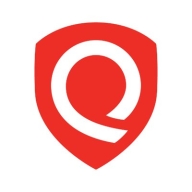

Vicarius vRx and Qualys Patch Management compete in the patch management category. Reviews indicate Qualys Patch Management has the upper hand due to its advanced features.
Features: Vicarius vRx users highlight its automated vulnerability assessments, real-time risk analysis, and user-friendly interface. Qualys Patch Management offers comprehensive patch coverage, integration capabilities, and superior feature richness.
Room for Improvement: Vicarius vRx users mention occasional scalability issues, a need for more integrations, and limited customer service resources. Qualys Patch Management feedback points to complexity in initial setup, difficulty in interface navigation, and higher initial costs.
Ease of Deployment and Customer Service: Vicarius vRx offers easy deployment but lacks extensive customer service resources. Qualys Patch Management involves a more complex deployment process but provides robust customer support.
Pricing and ROI: Vicarius vRx is noted for its affordable setup costs and quick ROI. Qualys Patch Management has higher initial costs but users feel the range of features justifies the investment.
With Qualys, we can save around 70 percent of time and between 30 to 40 percent of money.
We have a 50 percent return on investment due to reduced operational complexity and increased efficiency in patching and detection.
We have achieved significant time savings of 90 percent, primarily due to comprehensive oversight and visibility of security issues.
The support team is experienced and responsive.
The support team is responsive and provides detailed information.
Whenever we raise a request and mention the priority of the ticket, they respond immediately via email or call.
Their support is very good, and they respond quickly.
During the POC and the implementation, they were very available and made their best efforts to help us.
Whenever I've contacted them, they respond promptly with a callback or by email.
It scales efficiently across different machines globally, ensuring patches are deployed smoothly.
Qualys Patch Management is a globally scalable product, easily handling increasing workloads and users.
They introduce new modules as needed, making Patch Management highly scalable.
It is very simple; you just script it, and then the computers connect themselves.
When we attempted to scale this and update 200 systems, that just locked it.
We have some clients with up to a thousand agents.
I would rate the stability of Qualys Patch Management nine point five out of ten.
The stability of Qualys Patch Management is impeccable.
Overall, it is reliable.
There are some issues that they do not even know how to fix at this point.
I would rate the stability of Vicarius vRx ten out of ten.
There are some issues like high CPU usage during updates, but these were fixed.
There is a limitation where Qualys may not always offer solutions for remediation, particularly for end-of-life or end-of-service applications.
It would be better if Qualys Patch Management identifies whether the process has failed at the first instance and provides a retry button or retry mechanism, allowing retries for failed patches.
Collaborating with various vendors to provide new patches would be beneficial.
I am pretty sure that the tool works great when it comes to Windows, but when you are in an environment that has different flavors of Linux at different version levels, that may pose an issue.
We have the ability to search across the network for all switches, routers, and printers, but some devices might be outdated and have vulnerabilities.
Enhancing Vicarius vRx with improved third-party integrations, like notifications for external systems, and increased cloud integration for richer instance information, would be valuable improvements.
We get many more features at the same price as other solutions such as Microsoft SCCM.
The pricing is reasonable and less expensive than the previous tool.
We found it costly compared to other vendors.
It was very cheap.
In the past, Vicarius vRx was cheap, but now they have adjusted their pricing policy, resulting in higher renewal costs.
From a pricing perspective, Vicarius was cheaper compared to other competitors.
We leverage this functionality to deploy scripts that adjust registry values, effectively patching vulnerabilities and enhancing the security of our machines.
We have been able to apply workarounds for zero-day vulnerabilities efficiently.
It provides insight into the organization's security posture and keeps databases updated with new CVEs.
It's a valuable tool that reduces tension between IT and security teams by providing time to properly install patches.
The system prioritizes vulnerabilities, identifying high, medium, and low risks, allowing us to focus on high-risk applications.
The most valuable feature is the system's ability to provide information about open CVEs and how it compares the local version with available updates.


Qualys Patch Management optimizes patching and vulnerability remediation through automation and intelligence insights, accelerating the process by 43% and improving patch rates by 90%. Its integration with CMDB and ITSM tools speeds up ticket closures by 60%, effectively reducing the attack surface while freeing IT and security resources. This cloud-based solution bridges the IT-security gap, making it essential for cybersecurity.
Vicarius vRx supports managed service providers and partners with compliance packages, vulnerability management, and patching for PCI, HIPAA, and cybersecurity needs, focusing on third-party and OS patching, especially on Microsoft Windows.
Vicarius vRx automates patching, virtualized patching, and severity prioritization through its cloud-based, agent-based approach which enhances consistency and flexibility. It includes patchless protection to block malware in unpatched software and features simplified dashboards for integrated vulnerability discovery and remediation. Users appreciate the user-friendly scripting engine, efficient third-party software patching, and real-time cybersecurity updates. Community support and customizable deployment options further add value. However, users find name changes and login difficulties confusing and report tediousness when configuring multiple reports. Desired improvements include virtual environment for patch testing, enhanced network device vulnerability scans, and better Microsoft Endpoint Manager interactions.
What are the key features of Vicarius vRx?Among managed service providers, Vicarius vRx is implemented for updating systems, showing capabilities to customers in lab environments, and securing endpoints through agent-based patching. These providers use vRx to efficiently manage third-party software patching and to maintain cybersecurity standards across industries.
We monitor all Patch Management reviews to prevent fraudulent reviews and keep review quality high. We do not post reviews by company employees or direct competitors. We validate each review for authenticity via cross-reference with LinkedIn, and personal follow-up with the reviewer when necessary.